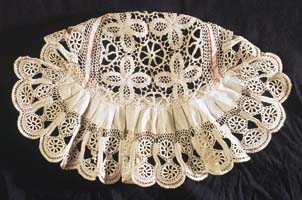Juraj Zajonc
A clew of yarn and piece of wire or thin sticks ending with an eye or hoop was for centuries sufficient for creating textiles whose base are loops or curls made from a single thread structured as knitting. One advantage was the simplicity of knitting: easy transportation of the textile being created, knitting at a convenient time, no restrictions on the size or shape of the knit textile. The techniques of knitting from a never-ending yarn can be found in the culture of the original as well as the current inhabitants of America and Africa, Asia and Europe. The most widespread form was knitting on sticks and crochet. Despite their universal character, several variations in the shapes, patterns and colours of the knit textile as well as technological differences in knitting itself have developed. The oldest knitting technique from a single thread is needle knitting. It is the basis for the technique of sewn lace. In the traditional folk textile of Slovakia, it is known from the surroundings of Trnava as embroidery – filling circular holes in textiles. Both the ending and connecting stitches were created from loops sewn by a needle. In Slovakia, knitting on sticks was known only from the 20th century in two types: as work for men it was knitting shoes, while women knitted socks, gloves, sweaters and aprons. Crochet started to spread on a larger scale in Europe at around the end of the 16th century. It continually started to substitute for some older textile techniques. In traditional Slovak folk textile production, crochet lace started to substitute mainly for bobbin lace. On the territory of Slovakia, a specific type of crochet lace appeared. It was based on the Irish pattern in technique and organization method. In order to improve the economic plight of the inhabitants of Rožnava, Štítnik and their surroundings at the beginning of the 20th century, bobbin and crochet lace courses were organized for girls. The lace was named Štítnik lace from the name of the town. The basis for fork crocheting is a hook (in Western Europe it was called Maltese lace). This technique was used in some areas of western Slovakia to decorate the border of headscarves and collars on female shirts as a part of folk dress.
